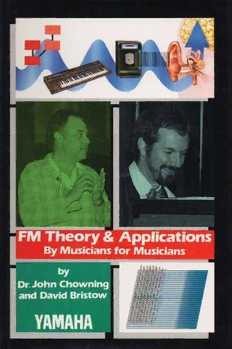
Fm Theory and Applications: By Musicians for Musicians PDF
Preview Fm Theory and Applications: By Musicians for Musicians
FM Theory & Applications By Musicians for Musicians 147 Dr.John Chowning and David Bristow a FM Theory & Applications By Musicians for Musicians by Dr. John Chowning and David Bristow First published in 1986 by Yamaha Music Foundation, 3-24-22 Shimomeguro Meguroku, Tokyo, Japan Copyright © 1986 by YAMAHA MUSIC FOUNDATION ISBN 4-636-17482-8 COO73 All rights reserved. Nopart ofthis publication may be reproduced or transmitted in any form or by any means,electronic or mechanical, including photocopy, recording, or any information storage andretrieval system, without permission in writing from the publisher. Printed and bound in Japan by YAMAHA MUSIC FOUNDATION Designed by P & B DesignAssociates, Milton Keynes. CONTENTS FOREWORD) sccveccsessscrscsense Vv 1.ANINTRODUCTION. 7 2. SOMEBASIC IDEAS 17 3. WHATIS FM? «0.0000 41 4. SIMPLE FM — TheTheory 55 5. SIMPLE FM — The Practice . 83 6. COMPLEX FM...... 113 7.APPLICATIONS.... . 139 APPENDIX 1 — Logarithmic Representation and “Pitch Frequency”... 160 APPENDIX2 — “X” Synth Comparisons by Index vs. Op. OutputLevel 165 APPENDIX3 — Bessel Functions Graphs... 170 APPENDIX4 — Bessel Function Tables. 179) APPENDIX5 — A Short Bibliography. pet ES! APPENDIX6 — A Glossary of Terms... ce 190) APPENDIX 7 — The Sampling Rate of the DX7. . 194 ACKNOW/LEDGEMENTS This book grew out of an original intention to prepare a short tutorial on the fundamental theory of FM synthesis. As you cansee,it didn’t stay short, and we would like to thank those people and institutions who have supported us in achieving a complete text. At IRCAM in Paris, where Pierre Boulez has generously encouragedthis work, our thanks to David Wesselfor his continuous support and Stephen McAdamsforhis useful backgroundinformation on acoustics;to Emmanuel Favreau and DanTimisfor their help with someofthe figures, and to Robert Gross and Michelle Dell-Prane for their assistance in mastering the main-frame computer and notleast in. maintaining our computer link between IRCAM and CCRMA, Stanford in the latter stages of our work. Inthe USA,thanks to Gary Leuenbergerforhis programming work and supportand to the staffand colleagues at CCRMA,Stanford for their help overthe years.Finally, our thanks to the research and developmentteamatLM Division, NipponGakkiLtd. inJapan, whotooktime and time and trouble to answer our requests for information regarding the details ofthe “X” Series synthesizers,to Phil Brimble, who took care of the graphics, andtoJerry Uwins, Jean-Claude Risset,andDougKeislarforthefinaleditingofthiswork. FOREV/ORD John Chowning — the inventor of FM Sound Synthesis Technique — and David Bristow — the gifted DXSeries FM Voice Maker — have collaborated to producethis extremely useful “theory meets practice” book. Their emphasis is on putting FM theory to work, enabling musicians to obtain more expressively potentcontrol over their FM instruments. Oneofthe really wonderful things aboutthis bookis that otherwise inaccessible information from acoustics and Psychoacoustics is clearly explained and applied to musical voicing practice. David Wessel IRCAM,Paris CHAPTER1 AN INTRODUCTION The remarkable acceptance of the “X” Series musical instruments produced by Yamahahas led to an equally remarkable need for understanding how the theory of frequency modulation (FM) synthesis can be effectively used in the creation of musicalsounds.Inthisbookwehavegleanedfromtheexperienceofmanymusicians and composers over manyyears whatwebelieve to be the mosteffective meansof understanding anduse. There is much to learn thatwe can only touch uponin this text — about acoustics, psychoacoustics (auditory perception), basic mathematics and indeed musicitself. But touch upon them wemust,for ifwe are to gain a useful understanding ofFM synthesis we mustbroadenourscope. The required additional effort will surely be worthit,since the knowledge acquired will be of more general use than simply understanding basic FM synthesis. W/e will relyonyourdiligence to read the bookintelligently and seek additional sources, for which direction will be given. Computation Transformation Synthesis Artistic Gesture In our belief that it is of utmost importance always to rely upon our ears for a practical and comprehensive understanding,we encourage you to read this book with an “X”Series synthesizer at hand. As a tool we have found it to be a most extraordinary aid in elucidating acoustic and psychoacoustic phenomena, as well as providing the basis of understanding FM. You will see that our strategy is rather different from other texts on FM in that we are not presenting a recipe book of “patches,” but rathera meansto understanding,creating, and modifying them.Ifwe are to be positive in ourapproachto synthesis and FM,a consideration ofthe whole musical process is important; an awareness of the nature of the transmission and perception of musical sounds will be of great value when considering thedetails of FM sound synthesis. The picture belowis to remind usthat the total conceptwecall Fig. 1.1 Transmission Acoustics Psychoacoustics
